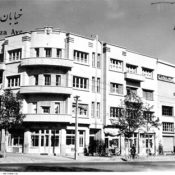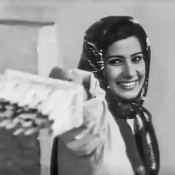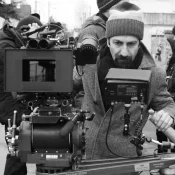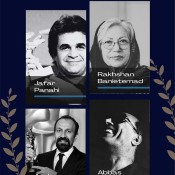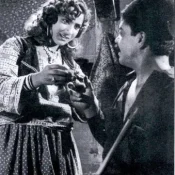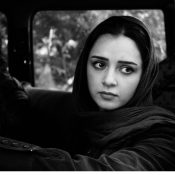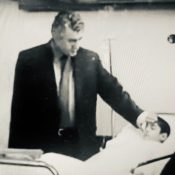Title
Author
Black Seals: Missive from Iran’s National Music
Figure 1: Still from the film Love Stricken (Dilshudigān), directed by ‘Alī Hātamī, 1992. The cathedral leaves its locale to be received in the studio of a lover of art; the choral production, performed in…
Freedom of Movement: Patriarchy, Gender and Space in Iranian Cinema
Figure 1: A still from the film Radiograph of a Family (Rādīyugrāphī-i yak khānavādah), directed by Fīrūzah Khusruvānī, 2020. Introduction Who gets access to which spaces, and why, remains a globally contentious issue. How does…
The Seed of a Sacred Art: Muhammad Rasūluf Dreams for All
Prologue By the time Muhammad Rasūluf’s film The Seed of the Sacred Fig (2024), after making its way through multiple festivals and a few public screenings, arrived at the small, independent, and well-supported Lüneburg’s SCALA,…
The Garden of Earthly Utopias: On Shirin Neshat’s Women Without Men
How might we imagine a utopian space in a past saturated by political trauma without assuming it can be fully recuperated? The question takes on particular urgency when we confront moments like the 1953 CIA-engineered…
Rebels with a Camera: Critical Zones and the Aesthetics of Iran’s Underground Cinema
Figure 1: A still from the film Critical Zone (Mantaqah-yi Buhrānī), directed by ‛Alī Ahmadzādah, 2023. Since the 1979 Islamic Revolution, the term “underground art” in Iran has been widely used but is sometimes misapplied….
Wandering through Film Clips: Iran in the Eyes of Others
Figure 1: St. Petersburg, awaiting the arrival of Muzaffar al-Dīn Shah in 1902. In addition to the films of Mirza Ibrāhīm Khan ‛Akkāsbāshī, created before the Constitutional Revolution of 1905, and Georges Ismā‛īluf’s news report…
Configurations of Expertise: Sardar Sager in Tehran’s Film Studios
Figure 1: Poster for Tomorrow is Bright (Fardā Rushan Ast), directed by Sardar Sager, 1960. Sardar Sager’s filmmaking career in Iran is the best kind of anomaly. He was the most prominent film professional to…
Film Adaptations and Narrative Change in Persian Fiction
Figure 1: A still from the film Shāzdah Ihtijāb (Prince Ihtijāb), directed by Bahman Farmānārā, 1974. Imagine living in the 18th or 19th century, before the advent of cinema and the introduction of movies into…
Woman, Witness, Freedom. Towards a Feminist Historiography of Iranian Cinema
“Martyrdom is a trap for the oppressed.” Éric Vuillard (The War of the Poor) Introduction “Jin, Jiyan, Azadî” (“Woman, Life, Freedom”), the central slogan…
The Anthropological Unconscious of Iranian Ethnographic Films
Ethnographic filmmaking—defined as making films that represent one culture to another or to itself—emerged in Iran in the 1960s, driven by many factors, such as rapid modernization and the resulting population displacements and psychic and…
Abbas Kiarostami as a Universal Filmmaker
Figure1: ‛Abbās Kiyārustamī with the Palme d’Or for Best Director, the Cannes Film Festival, 1997. Paradoxically, the status of ‛Abbās Kiyārustamī (1940-2016) as a universal filmmaker appears to be one of his most underrated virtues….
Bahram Beyzaie’s Dramatic and Cinematic Oeuvre
Introduction In this entry, I trace the trajectory of Bahrām Bayzā’ī’s creative impulse and examine his oeuvre to offer an analytical overview of his aesthetic and thematic concerns and innovations. Before embarking on my chronological…
Beyond Stories and Facts: On Abbas Kiarostami’s ‘Documentary Objects’
Figure 1: Portrait of ‛Abbās Kiyārustamī. ‛Abbās Kiyārustamī’s work has often been praised for displaying at once formal simplicity and sophisticated emotional registers. This simplicity can be observed both in Kiyārustamī’s acclaimed narrative work and…
Armenian Architects and the Pahlavī Movie Theater
Introduction1With changes and additions, this essay is a section from my articles, published under the title “Leisure Architecture and the Aesthetics of the Pahlavi ‘Modern Middle Class’,” in Political, Social and Cultural History of Modern…
Screening Love: The Forbidden in Rakhshan Banietemad’s Narges (1992)
Before the narrative even begins, Rakhshān Banī-i‛timād’s Nargis (Nargess) of 1992 directly engages the theme of love. As the film opens accompanied by the melodic score, a close-up of a conventional bride and groom figurine…
Asghar Farhadi: A Master of Moral and Aesthetic Ambiguity
Asghar Farhādī was born in 1972 in Humāyūnshahr, also known as Sidah (now called Khumaynīshahr), on the outskirts of Isfahan. He gravitated towards theater and film at an early age despite having no obvious family…
The International Reception of Iranian Cinema
Introduction Iranian cinema entered the European film festival scene in the 1960s. The first Iranian film to screen at Cannes was Mostafa Farzaneh’s…
Internet Cinema: A Cinema of Embodied Protest
This article is about an emergent form of cinema in whose production and propagation most of us have participated in one way or another. I will concentrate on its manifestation in Iran around the political…
Alternative Cinema: A Cinematic Revolution Before 1979
Iranian pre-revolutionary cinema has been characterized by different cinematic trends. While distinct in their modes of production, cinematic grammar, means of circulation, and reception, these cinematic trends were connected and overlapping. Starting in the late…
Filming Locations as a Defining Feature of Fīlm-Fārsī (1930-1978)
The choice of location was a crucial aspect in the creation of most Iranian films from the 1930s to the end of the 1970s. These locations depicted in Iranian cinema become significant parts of the…
Behrouz Vossoughi: The Cult Star of Failed Rebellious Masculinity
Figure 1: Bihrūz Vusūqī, A screenshot from the film Dashnah (The Dagger). Introduction Né Khalīl Vusūqī on March 11, 1938, in the city of Khuy, Bihrūz Vusūqī made his entry into the Iranian film industry…
The Buttressing Gaze: Neopatriarchal Unconscious and the Biopolitics of Female Visibility in Iranian Cinema
Introduction In the aftermath of Mahsa Amini’s untimely death in September 2022, following her arrest by the morality police for allegedly wearing an improper hijab, Iranian women took center stage in the Women, Life, Freedom…
The Representation of Drugs in Iranian Arthouse Cinema and Their Social Context (2000-2025)
Figure 1: Still from Critical Zone (Mantaqah-yi buhrānī), directed by ‘Alī Ahmadzādah, 2023. The Rise of the Social Issues “Genre” in Cinema Under Muhammad Khātamī’s Reformist Presidency In 1999 a seminal conference on Iranian cinema…
Collective Sensuality: Exploring the Intimate Geographies of Cinema in Iran
Introduction From its inception cinema has been defined by its capacity to foster collective experience. The Lumière brothers’ inaugural 1895 public screening on Boulevard des Capucines, Paris, was not only a technological breakthrough but also…
Doctors and Medical Ethics in Post-Revolutionary Iranian Cinema
Figure 1: Poster of the film A House Built on Water (Khānah-ʾī rūy-i āb), directed by Bahman Farmān-Ārā, 2002. Introduction: The Portrayal of a Type In exploring modern Iranian literature and cinema, one can see…
A
- Abbas Kiarostami as a Universal Filmmaker
- Abbas Kiarostami, Asghar Farhadi, and Iranian Francophilia: Copie conforme, Le passé, and French Cinematic Affinities
- Abbas Kiarostami| ‛Abbās Kīyārustamī| عباس کیارستمی
- Abolfazl Purarab/Abolfażl Pūrārab/ابوالفضل پورعرب
- Abolhassan Davoodi/Abu Al-hasan Dāvūdī/ابوالحسن داوودی
- Accented Cinema: Muhsin Makhmalbāf’s Transnationalism
- Afsānah Bāyigān | Afsaneh Bayegan | افسانه بایگان
- Ahmad Reza Darvish/Ahmad Rizā Darvīsh/احمدرضا درویش
- Alireza Davood-Nejad/‛Alī Rizā Dāvūd-Nizhād/علیرضا داوودنژاد
- Ali Hatami | ‛Alī Hātamī | علی حاتمی
- Alternative Cinema: A Cinematic Revolution Before 1979
- Amir Naderi as American Indie: Reading Manhattan By Numbers as an Iranian Film
- Amir Naderi/Amīr Nādirī/امیر نادری
- Ana Lily Amirpour’s A Girl Walks Home Alone at Night (2014)
- Apartment Dramas in Iranian Cinema (2009-present)
- Arbi Hovhannisean | Ārbī Uvānisiyān | آربی آوانسیان
- Architecture as a Liminal Space in Universal Language by Matthew Rankin
- Armenian Architects and the Pahlavī Movie Theater
- Asghar Farhadi and the Dubious Conscience of Post-Revolutionary Iran
- Asghar Farhadi | Asghar Farhādī | اصغر فرهادی
- Asghar Farhadi: A Master of Moral and Aesthetic Ambiguity
- Audacious Cinema: Transfiguration of ethical storytelling in Iran
- A Historical Wound: The Role of Ta‘ziyah as a Theater-Ritual in Iranian Cinema
- A Moment of Innocence | Nūn va guldūn | نون و گلدون
- A Party in Hell | Shab’nishīnī dar jahannam | شب نشینی در جهنم
- A Separation | Judāʾī-i Nādir az Sīmīn | جدایی نادر از سیمین
B
- Bahman Farmanara | Bahman Farmānārā | بهمن فرمان آرا
- Bahman Ghobadi | Bahman Qubādī | بهمن قبادی
- Bahram Beyzaei | Bahrām Bayzāyī | بهرام بیضائی
- Bahram Beyzaie’s Dramatic and Cinematic Oeuvre
- Bashu, the Little Stranger| Bāshū gharībah-yi kūchak | باشو، غریبه کوچک
- Beehive | Kandū | کندو
- Behrouz Afkhami/Bihrūz Afkhamī/بهروز افخمی
- Behrouz Vossoughi: The Cult Star of Failed Rebellious Masculinity
- Behruz Vosuqi/Behruz Vosūqī/بهروز وثوقی
- Between Fire and Mirror: Ibrāhīm Gulistān’s Cinematic Journey
- Beyond Stories and Facts: On Abbas Kiarostami’s ‘Documentary Objects’
- Black Seals: Missive from Iran’s National Music
- Brick and Mirror | Khisht va āyīnah | خشتو آیینه
- Bārān Kawsarī | Baran Kosari | باران کوثری
C
- Children of Heaven | Bachchah’hā-yi Āsmān| بچههای آسمان
- Children’s Cinema | Sīnima-yi Kūdak | سینمای کودک
- Children’s Cinema in Iran: The Alpha Generation and the Transformation of the Child Spectator
- Cinematic Male-Female Relationships
- Cinema and sports in Iran | سینما و ورزش در ایران
- Cinema Dar Qāb Tambr
- Cinema Rex Fire
- Circumventing Censorship in Iranian Cinema: On Unruled Paper and What Time Is It in Your World?
- Close Encounters of the Fifth Kind: An Analysis of Iranian Science Fiction
- Close Up | Kluz-āp | کلوزآپ
- Collective Sensuality: Exploring the Intimate Geographies of Cinema in Iran
- Configurations of Expertise: Sardar Sager in Tehran’s Film Studios
- Corporeality, Absence, and Signifiance in Rakhshān Banī-I‛timād’s Cinema: A Case Study of The Blue-Veiled
- Cracking Biocinema: Biopoetical Intimacies in Pahlavi Iran
- Creating the image of “Decent Woman” in Iranian Films (1979-1989)
- Crime Genre in Iranian Cinema
- Crimson Gold | Talā-yi surkh̄ | طلای سرخ
- Cult for Context: The Curious Case of Mārmulak
D
- Dariush Mehrjui | Dāryūsh Mihrjūyī | داریوش مهرجویی
- Daryush Arjmand/Dāryūsh Arjmand/داریوش ارجمند
- Death of Yazdgerd | Marg-i Yazdgird | مرگ یزدگرد
- Doctors and Medical Ethics in Post-Revolutionary Iranian Cinema
- Documentary Iran in The 1950s: Village Films, Akhbār-i Irān Series, & The Cold War Story of US Government’s Documentary Diplomacy
- Documenting Iran in the 1950s: Village Films
- Domestic Violence in Contemporary Iranian Cinema
- Downpour | Ragbār | رگبار
- Dukhtar-i Lur (Īrān-i imrūz va Īrān-i dīrūz) | دخترِ لُر (ایران امروز و ایران دیروز)
E
- Ebrahim Golestan | Ibrāhīm Gulistān | ابراهیم گلستان
- Ebrahim Golestan: Pioneering Narratives in Iranian Cinema
- Ebrahim Hatamikia | Ibrāhīm Hātamīkīyā | ابراهیم حاتمی کیا
- Ebrahim Khan Sahafbashi
- Ekhrajiha | Ikhrājīhā | اخراجی ها
- Encounters with the Stranger: Home, Displacement, and Identity in Bahram Beyzai’s Cinema
- Esmail Koushan | Ismāʻīl Kūshān | اسماعیل کوشان
- Exploiting Sīghah: Gender, Power, and the Marginalization of Women in Iranian Media
- Ezzatollah Entezami/Ezzatollāh Entezāmī/عزت الله انتظامی
F
- Fakhrī Khurvash | Fakhri Khorvash | فخری خوروش
- Farhad Ayish/Farhād Ā’īsh/فرهاد آئیش
- Farīdūn Rahnamā’s Postmodernist Approach in Siavash in Persepolis
- Farrokh Ghaffari | Farrukh Ghaffārī | فرخ غفاری
- Farsi Movie | Fīlmfārsī | فیلمفارسی
- Farzānah Ta’īdī | Farzaneh Taidi | فرزانه تاییدی
- Farīdūn Gulah (Fereydun Goleh): An Enduring Mystery
- Farīdūn Rahnamā’s Filmic Utopia in Iran’s Son Is Unaware of His Mother
- Farīmāh Farjāmī | Farimah Farjami | فریماه فرجامی
- Femininity and Modernity in The Sealed Soil by Marva Nabili
- Fereydoun Jeyrani/Farīdūn Jayrānī/فریدون جیرانی
- Fereydoun Rahnema | Farīdūn Rahnamā | فریدون رهنما
- Fereydun Goleh | Farīdūn Gūlah | فریدون گُله
- Filming Locations as a Defining Feature of Fīlm-Fārsī (1930-1978)
- Film Adaptations and Narrative Change in Persian Fiction
- Film Dubbing
- Film Dubbing Before 1979
- Film Music | Mūsīqī-i Fīlm | موسیقی فیلم
- Film Music | Mūsīqī’yah film | موسیقی فیلم
- Film Production at Kānūn-i Parvarish-i Fikrī
- Film-Farsi and Everyday Life: Popular Cinema and Modernity in Pre-Revolutionary Iran
- Forced Empathy and the Geopolitics of Memory in Bahman Ghobadi’s Films
- Forouzan (Parvin Kheirbakhsh) | Furūzān (Parvīn Khayrbakhsh) | فروزان (پروین خیربخش)
- Forouzan (Parvin Kheirbakhsh) | فروزان (پروین خیربخش)
- Freedom of Movement: Patriarchy, Gender and Space in Iranian Cinema
- From Golden City to Felestin: The Onomastics of Cinema Halls in Tehran
- From Hollywood to Tehran: American Movies in Iran Before the Revolution American Dreams in Iranian Theaters: Hollywood’s Rise Before 1979
- From Karkheh to Rhein| Az Karkhah tā Rāyn | از کرخه تا راین
- From Mongols to Television and Cinema
- From Persian Cats to Rap and Revolution: The Battleground for Love, Freedom, and Human Rights in Iran and its Diaspora
- From The Lor Girl to Bride of Fire: Tribal Women in Iranian Cinema
- From “Golden City” to “Felestin”: The Onomastics of Cinema Halls in Tehran
- Furūzān Bihrūz | Forouzan Behrouz | فروزان بهروز
- Fātimah Mu‛tamid’āryā | Fatemeh Motamed-Arya | فاطمه معتمدآریا
G
H
- Hadīyah Tihrānī | Hedieh Tehrani | هدیه تهرانی
- Haji Agha, the Cinema Actor | Hājī Āghā Āktur-i Sīnamā | حاجیآقا اکتور سینما
- Hamid Nematollah/Hamīd Nimatallāh/حمید نعمت الله
- Hamid Reza Ashtianipoor/Hamīd Rizā Āshtīyānīpūr/حمیدرضا آشتیان پور
- Hamoun | Hāmūn| هامون
- Hamīdah Khayrābādī | Hamideh Kheirabadi | حمیده خیرآبادی
- Hasan, the Bald | Hasan-Kachal | حسن کچل
- Hauntologies of The Present: Notes on Politics of Friendship in Férydoun Rahnéma’s Modernism
- Hingāmah Ghāzīyānī | Hengameh Ghaziani | هنگامه قاضیانی
- Home in Cinema and Women at Home (1969–1999)
- Home in Cinema and Women at Home: A Comparative Study of Pre- and Post-Revolutionary Iranian Cinema from 1969 to 1999
- Horror & Authority in Farrokhzad’s Khānah Siyāh Ast
- Hosayn Panahi/Ḥosayn Panāhī/حسین پناهی
- Hossein Alizadeh’s Film Scores
- How Frightening Your Makings: Epidemics, Mass Metamorphoses, and Bodies of the Iranian New Wave Cinema
- Humā Rūstā | Homa Rousta | هما روستا
- Hyper-Realism in Digital Films by Abbas Kiarostami
- Hānīyah Tavassulī | Hanieh Tavassoli | هانیه توسلی
I
- Ideological Cinema in Iran
- Ideology and Social Classes in Twenty-First Century Iranian Cinema
- Impasse | Tangnā | تنگنا
- Internet Cinema: A Cinema of Embodied Protest
- Invectivity in Asghar Farhadi’s Movie
- Iraj Tahmasb/Īraj Tahmāsb/ایرج طهماسب
- Iranian Cinema and International Film Festivals: A Crossroads Between Arts and Politics
- Iranian cinema and masculinity | Sinimā-yi Īrān va mardānigī | سینمای ایران و مردانگی
- Iranian Cinema and Women | Sinimā-yi Īrān va zanān | سینمای ایران و زنان
- Iranian Horror Cinema
- Iranian Poetic Cinema: Historical Perspectives and Reflections
- Iranian Women Filmmakers
- Iran Is My Home (Īrān Sarā-yi Man Ast)
- Iran’s Cinematic Winter; Under The International Politics
- Irene Zazians | ایرن زازیانس
- I’m Taraneh, 15 | Man Tarānah 15 sāl dāram | من، ترانه 15سال دارم
J
K
- Kamal Tabrizi/Kamāl Tabrīzī/کمال تبریزی
- Kambuzia Partovi/Kāmbūzīyā Partuvī/کامبوزیا پرتوی
- Katāyūn Amīr-Ibrāhīmī | Katayoun Amir-Ebrahimi | کتایون امیرابراهیمی
- Katāyūn Rīyāhī | Katayoun Riahi | کتایون ریاحی
- Khosrow Shakibaei/Khosrow Shakībāʾī/خسرو شکیبایی
- Khosrow Sinai/Khusraw Sīnāyī/خسرو سینایی
- Kianoush Ayari | Kīyānūsh ‛Ayyārī | کیانوش عیاری
- king of the hearts | Sultān-i qalb’hā | سلطان قلبها
- Kiumars Pourahmad/Kīyūmars Pūrahmad/کیومرث پوراحمد
M
- Magnificent Productions (Film-ī Fākhir) or Islamic Blockbusters of 2005-2013
- Mahdī Ivanov (Rūsī Khan): The Enigmatic Pioneer of Iranian Cinema
- Mahtāb Karāmatī | Mahtab Keramati | مهتاب کرامتی
- Mahīn Shahābī | Mahin Shahabi | مهین شهابی
- Majid Majidi/Majīd Majīdī/مجید مجیدی
- Malakah Ranjbar | Malakeh Ranjbar | ملکه رنجبر
- Male-Female Relationship in Post-Revolutionary Iranian Cinema
- Mani Haghighi/Mānī Haqīqī/مانی حقیقی
- Marvā Nabīlī: Woman, Rebel, Artist, Exile
- Marvā Nabīlī’s The Sealed Soil as Slow Cinema
- Maryam Amīrjalālī | Maryam Amirjalali | مریم امیرجلالی
- Marzieh Boroomand/Marzīyah Burūmand/مرضیه برومند
- Masoud Abparvar/Mas‛ūd Ābparvar/مسعود آبپرور
- Masoud Jafari-Jozani/Mas‛ūd Ja‛farī Jawzānī/مسعود جعفری جوزانی
- Masoud Kimiai | Mas‛ūd Kīmīyāyī | مسعود کیمیایی
- Mehdi Fakhimzadeh/Mahdī Fakhīmzādah/مهدی فخیم زاده
- Mehdi Missaghieh | Mihdī Mīsāqīyyah | مهدی میثاقیه
- Meteoric Rise and Demise of Rūhangīz Sāmīnizhād, Iran’s First Actress
- Mirīlā Zāri‛ī | Merila Zarei | مریلا زارعی
- Mohammad Ali Fardin/Moḥammad ʿAlī Fardīn/محمدعلی فردین
- Mohammad Reza Aslani | Muhammad Rizā Aslānī | محمدرضا اصلانی
- Mohsen Amiryoussefi/Muhsin Amīryūsufī/محسن امیریوسفی
- Mohsen Makhmalbaf | Muhsin Makhmalbāf | محسن مخملباف
- Morteza Hannaneh | Murtizā Hannānah | مرتضی حنانه
- Moḥammad Ali Keshavarz/Moḥammad ʿAlī Keshāvarz/محمد علی کشاورز
- Mushegh Sarvarian | Mūshiq Sarvarī (Sarvarīyān) | موشق سروری
- Mītrā Hajjār | Mitra Hajjar | میترا حجار
N
- Nargess | Narghis | نرگس
- Naser Malek Motiei | Nāsir Malak-mutī‛ī | ناصر ملک مطیعی
- Naser Malek Motiei | ناصر ملکمطیعی
- Nasser Taghvai | Nāsir Taqvāyī | ناصر تقوایی
- Nativism and Utopia in Parviz Kimiavi’s OK Mister
- Navid Mohammadzadeh/Navīd Moḥammadzādeh/نوید محمدزاده
- New Wave Cinema | Sīnamā-yi mawj-i naw̄ | سینمای موج نو
- Night of the Hunchback | Shab-i Qūzī | شب قوزی
- Nigār Javāhirīyān | Negar Javaherian | نگار جواهریان
- Nosratollah Karimi | Nusrat-Allāh Karīmī | نصرت الله کریمی
- Nīkī Karīmī | Niki Karimi | نیکی کریمی
- Nīkū Khiradmand | Nikoo Kheradmand | نیکو خردمند
- Nūrī Kasrā’ī | Nuri Kasrayi | نوری کسرایی
O
P
- Parsa Piruzfar/Pārsā Pīrūzfār/پارسا پیروزفر
- Parviz Goes to College: A 1930s Missionary Film in Context
- Parviz Kimiavi | Parvīz Kīmiyāvī | پرویز کیمیاوی
- Parviz Sayyad | Parvīz Sayyād| پرویز صیاد
- Parviz Shahbazi/Parvīz Shahbāzī/پرویز شهبازی
- Parvānah Ma‛sūmī | Parvaneh Massoumi | پروانه معصومی
- Parīnāz Īzadyār | Parinaz Izadyar | پریناز ایزدیار
- Payman Maadi/Paymān Maʿādī/پیمان معادی
- Petrocinema| سینما و صنعت نفت
- Pigāh Āhangarānī | Pegah Ahangarani | پگاه آهنگرانی
- Poetic Minimalism of Iranian Cinema: Pre-Revolution to New Wave
- Poetic Pictures: The Feminization of Iranian Cinema
- Postmodern Storytelling in Iranian Cinema: Shahram Mokri Films
- Post-Revolutionary Masculinities
- Pouran Derakhshandeh/Pūrān Dirakhshandah/پوران درخشنده
- Precarity and Possibility: The Labor of Underground Video Dealers in Iran
- Prince Ehtejab | Shāzdah Ihtijāb |شازده احتجاب
- Public Taste in Films
- Pānti’ā Bahrām | Pantea Bahram | پانتهآ بهرام
- Pūrī (Siddīqah) Banāyī | Pouri (Seddigheh) Banayi | پوری بنایی
Q
R
- Rakhshan Banietemad | Rakhshān Banī’iʿtimād | رخشان بنیاعتماد
- Rasool Mollagholi Poor/Rasūl Mullāqulī’pūr/رسول ملاقلی پور
- Ra‛nā Āzādīvar | Rana Azadivar | رعنا آزادیور
- Rebels with a Camera: Critical Zones and the Aesthetics of Iran’s Underground Cinema
- Representation of Urban Ruins in Iranian New Wave Cinema
- Representation of Women in Rasūl Mullāqulīpūr’s Cinema
- Reproducing Gender Stereotypes in Iranian Women’s Cinema: A Comparative Analysis of Three Decades
- Resistance and Compliance in The Salesman (2016)
- Revolutionary cinema | Sīnimā-yi Inqilābī | سینمای انقلابی
- Reza Kianian/Rezā Kīānīān/رضا کیانیان
- Reza Mirkarimi/Rizā Mīrkarīmī/رضا میرکریمی
- Ruqayyah Chihrah-Āzād | Roghayeh Chehreh-Azad | رقیه چهره آزاد
- Ruyā Taymūrīyān | Roya Teymourian | رویا تیموریان
S
- Sacred Defense Cinema | Sīnamā–yi difāʿ–i muqaddas | سینمای دفاع مقدس
- Sacred Defense Cinema: From Defense to Intervention
- Saeed Pursamimi/Saʿīd Pūrsamīmī/سعید پورصمیمی
- Sahar Dawlatshāhī | Sahar Dolatshahi | سحر دولتشاهی
- Samira Makhmalbaf | Samīrā Makhmalbāf | سمیرا مخملباف
- Samuel Khachikian | Sāmūʼil Khāchīkiyān | ساموئل خاچیکیان
- Sartorial Islamic Baroque
- Screening Love: The Forbidden in Rakhshan Banietemad’s Narges (1992)
- Self-Reflexivity in Iranian New Wave Cinema
- Shahab Hoseyni/Shahāb Ḥoseynī/شهاب حسینی
- Shahed Ahmadloo/Shāhid Ahmadlū/شاهد احمدلو
- Shahlā Rīyāhī | Shahla Riahi | شهلا رياحي
- Shahram Mokri/Shahrām Mukrī/شهرام مکری
- Shahscoping Lahore: Elective Affinites in the Era of Regional Cooperation and Development
- Shapour Gharib/Shāpūr Qarīb/شاپور قریب
- Shattered Reflections: Mise en Abyme and the Deconstruction of Reality in Post-Revolutionary Iranian Cinema
- Shifting Paradigms: Childhood Constructs in Iranian Children’s Cinema Across Five Decades
- Shirin Neshat’s Land of Dreams: Moving From The Personal to The Universal
- Shirin | Shīrīn | شیرین
- Shirin | شیرین
- Shot in the Dark: Rakhshan Bani-Etemad’s Subversion of Patriarchally Constructed Femininity in The May Lady
- Shuhrah Āghdāshlū | Shohreh Aghdashloo | شهره آغداشلو
- Silent Cinema:A Global and Local Hybrid
- Sirus Alvand/Sīrūs Alvand/سیروس الوند
- Sīnamā-yi Mawj-i Naw
- Sohrab Shahid-Saless | Suhrāb Shahīd Sālis | سهراب شهید ثالث
- Sound Movies | Sīnamā-yi Nātiq̄ | سینمای ناطق
- South of the City | Junūb-i shahr | جنوب شهر
- Speaking through Pain: Feminist Testimony and Diasporic Resistance in Born in Evin
- Still Life | Tabī‛at-i bījān | طبیعت بیجان
- Surayā Qāsimī | Soraya Ghasemi | ثریا قاسمی
- Sūsan Taslīmī | Susan Taslimi | سوسن تسلیمی
T
- Tahmineh Milani | Tahmīnah Mīlānī | تهمینه میلانی
- Tahmīnah Mīlānī’s The Hidden Half: The Art of Archetypes and Flashbacks
- Taking Refuge in Nature: An Ecocritical Reading of Citizenship and Dispossession in Contemporary Iranian Cinema
- Tambourine | Dāyarah-ʼi Zangī | دایره زنگی
- Tangsir | Tangsīr | تنگسیر
- Tarānah ‛Alī-dūstī | Taraneh Alidoosti | ترانه علیدوستی
- Taste of Cherry | Taʿm-i Gīlās | طعم گیلاس
- Tawqi | Tawqī | طوقی
- Tehran in Iranian Post-Revolutionary Films
- Tehran’s Universal Studios
- The Aesthetic of Reality: The Poetry of Cinema in Muhammad Rizā Aslānī’s Films
- The Anthropological Unconscious of Iranian Ethnographic Films
- The Apple | Sīb | سیب
- The Buttressing Gaze: Neopatriarchal Unconscious and the Biopolitics of Female Visibility in Iranian Cinema
- The Child of the Sun and the Earth
- The Cinematic and Cultural Legacy of Farokh Ghafari
- The Cow | Gāv | گاو
- The Crow | Kalāgh | کلاغ
- The Cycle of Violence as a Path to Justice in the Film Bī hamah chīz
- The cycle | Dāyarah-ʼi Mīnā | دایره مینا
- The Death of Sign; A Poetic Cinema of Mohammad Rezā Aslāni
- The Deer | Gavaznhā | گوزنها
- The Empathic Female Look: Resistance and Dialogue in the Patriarchal Spaces of Fīlmfārsī Melodrama
- The Fateful Day | Rūz-i vāq‛ah | روز واقعه
- The Garden of Earthly Utopias: On Shirin Neshat’s Women Without Men
- The Heart-Brokens | Sūtah’dilān | سوته دلان
- The Hidden Half | Nīma-yiPinhān | نیمه پنهان
- The Horror Genre in Post-Revolutionary Iranian Cinema
- The House Is Black | Khānah siyāh ast | خانه سیاه است
- The Impact of Cinema on the Socio-Cultural Change in Iran
- The International Reception of Iranian Cinema
- The Introduction and Development of Cinema in Iranian Society and Culture
- The Iranian Occidentalist Gaze: Eroticizing Western Modernity and Patriarchal Reactions in Late Pahlavi Era Cinema
- The Iranian Occidentalist Gaze: Eroticizing Western Modernity and Patriarchal Reactions in Late Pahlavī Era Cinema
- The Janitor | Sirāydār | سرایدر
- The Lizard , Guidance Patrol, and Semiotic Guerrilla Warfare: Subversion and Resistance in Iranian Cinema
- The Middle-Class Poor in Iranian Cinema: Shattered Lives, Fading Horizons in At the End of the Night (2024)
- The Morning of the Fourth Day: The Iranian New Wave and its À Bout de Souffle
- The Night It Rained | Ūn shab kih bārūn ūmad | اون شب که بارون اومد
- The Philosophical Poetry of Makhmalbaf: On Time of Love (1991) and Sex and Philosophy (2005)
- The Representation of Drugs in Iranian Arthouse Cinema and Their Social Context (2000-2025)
- The Role of National Identity in the Development of Fīlmfārsī
- The Runner | Davandeh | دونده
- The Seed of a Sacred Art: Muhammad Rasūluf Dreams for All
- The Soundscape in Diasporic Iranian Cinema
- The Swallows return to the nest | Parastūhā Bi Lāna bār mīgardand | پرستوها به لانه بر می گردند
- The Tenants | Ejāre-nešinhā | اجاره نشینها
- Through the Olive Trees | Zīr-i Dirakhtān-i Zaytūn | زیر درختان زیتون
- Through the Olive Trees: Probing the Premise of ‘Reel’ Narrative in an Eco-poetic Film
- Towards A Micropolitics of Homo-eroticism In Shirin Neshat’s Women without Men
- To Live Is to Rebel: Khayyām’s Rubāʿiyāt, My Favourite Cake, and the Politics of Joy in Iran
- Transcending Realities The Poetic Evolution of Love in Dāryūsh Mihrjūyī’s Cinema (The Pear Tree and Dear Cousin is Lost)
- Transcending Realities; The Poetic Evolution of Love in Daryoush Mehrjooyee’s Cinema (The Pear Tree and Dear Cousin Is Lost)
- Travelers | Musāfirān | مسافران
- Two Women | DuZan | دو زن
U
W
Z
#
- “Tooba” in Rakhshan Banietemad’s Cinema
- A Dragon Arrives! (2016)
- A Simple Event (1973)
- Certified Copy (2010)
- Close-Up (1990)
- Iran’s Cinema in Pursuit of Happiness: Part I (1951-1971)
- Marjān and The House is Black: First Two Films by Iranian Women Directors
- Maybe Some Other Time (1988)
- Seventeen Days to Execution (1956)
- Taste of Cherry (1997)
- The Abadanis (1993): A Historical Testimony, Silenced
- The Swallows Return to The Nest (1964)
- Travelers (1991)
- Āzītā Hājīyān | Azita Hajian | آزیتا حاجیان
- ʿAlī Nāṣirīān/ʿAlī Nāṣirīān/علی نصیریان
- “Drama” in Selected Iranian Cinema Posters: A study in Structuralist Narratology
- “Primitive Apparatus”: The Dramaturgy of Hyperrealism in the Digital Cinema of ‛Abbas Kiarostami
- “Salaam Mumbai”: Pasts and Presents of Exchange and Collaboration Between Indian and Iranian Cinema

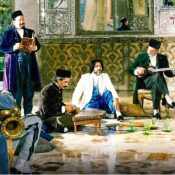





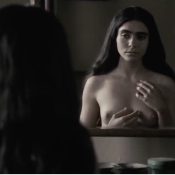



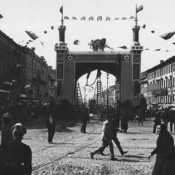





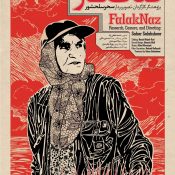

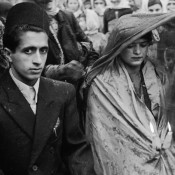



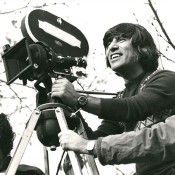
![Talajooy[39]](https://cinema.iranicaonline.org/wp-content/uploads/2022/07/Talajooy39-150x150.jpg)


